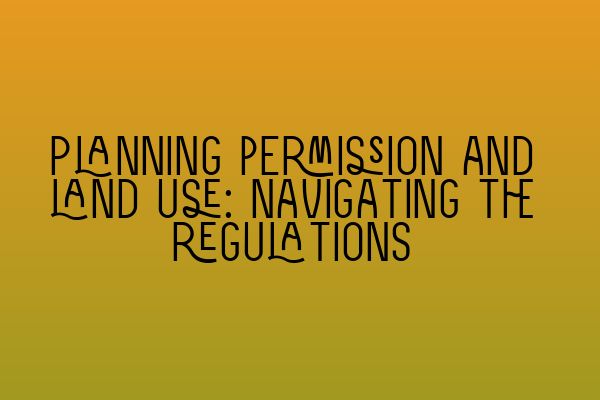Planning permission and land use: Navigating the regulations
When it comes to property development and land use, understanding the rules and regulations surrounding planning permission is crucial. Whether you are a property developer, landowner, or simply interested in the topic, having a good grasp of planning permission can save you from potential legal troubles and enhance your property ventures. In this blog post, we will delve into the intricacies of planning permission and provide you with valuable insights on navigating the regulations.
What is planning permission?
Planning permission is the formal consent required from the local authority to construct new buildings, make significant changes to existing structures, or change the use of a property or land. It ensures that development is carried out in accordance with local planning policies and national regulations, ultimately shaping the built environment.
Understanding the planning permission process
The planning permission process can be complex, but breaking it down into stages makes it easier to comprehend. Here are the key steps involved:
1. Initial research and consultation: Before diving into your project, it is crucial to conduct thorough research and consult with experts who can guide you through the planning process. Understanding the local development plan, zoning regulations, and any specific requirements for your property or land can help you make informed decisions.
2. Pre-application advice: Seeking pre-application advice from the local planning authority can be immensely beneficial. This step allows you to present your proposals and receive feedback on any potential issues, saving you time and money in the long run.
3. Submitting the application: Once you have finalized your plans, it’s time to submit your planning application to the local authority. This involves completing the relevant forms, providing supporting documents, and paying the necessary fees.
4. Application review: The local authority will review your application, considering factors such as the impact on the surrounding area, compliance with local policies, and potential objections from interested parties. This process usually takes a few weeks, but can vary depending on the complexity of the project.
5. Decision: After careful assessment, the local authority will either grant or refuse planning permission. In some cases, they may impose conditions that must be met before development can proceed. If planning permission is granted, you can proceed with your project. If it is refused, you have the option to appeal the decision.
6. Implementation: Once planning permission is obtained, you can commence your development or change of land use. It is important to adhere to any conditions set out in the permission and to notify the local authority of any substantial variations to the approved plans.
Navigating the regulations: Tips and considerations
Navigating the regulations surrounding planning permission requires careful attention to detail and a comprehensive understanding of the planning process. Here are some tips and considerations to bear in mind:
1. Engage professional expertise: Seeking advice from experienced professionals, such as property solicitors or planning consultants, can greatly assist you in understanding the regulations and ensuring compliance throughout the planning process.
2. Research local policies and guidelines: Familiarize yourself with the local development plan, zoning regulations, and any specific policies relevant to your property or land. This knowledge will help you align your proposals with the local authority’s vision for the area.
3. Consider public opinion: Engage with local communities and stakeholders early on in the planning process. Listening to their concerns and incorporating their feedback can strengthen your application and minimize potential objections.
4. Be flexible and adaptable: The planning process involves negotiation and compromise. Be open to making adjustments to your proposals to address any concerns raised by the local authority or interested parties, increasing your chances of obtaining planning permission.
5. Keep up with changes in legislation: Planning laws and regulations can change over time. Staying up to date with any amendments or updates ensures that you remain compliant and well-informed.
Conclusion
Planning permission is a vital aspect of property development and land use. Navigating the regulations surrounding planning permission requires careful research, consultation, and expertise. By engaging with professionals, understanding local policies, considering public opinion, and staying informed, you can optimize your chances of obtaining planning permission and successfully pursuing your property ventures.
For more information on property law, land law, and preparing for the Solicitors Qualifying Examination (SQE), check out our related articles:
– SQE 1 Practice Exam Questions
– SQE 1 Practice Mocks FLK1 FLK2
– SQE 2 Preparation Courses
– SQE 1 Preparation Courses
– SRA SQE Exam Dates
Remember, proper understanding and compliance with the regulations surrounding planning permission are crucial for the success and legality of your property endeavors.
